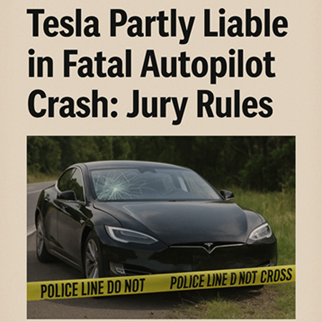A Florida jury found Tesla partly at fault in a 2019 fatal crash involving Autopilot, awarding $329M in damages. Here’s what the verdict means for Tesla.

⚖️ Tesla Found Partly Liable in Fatal Autopilot Crash: Full Jury Verdict Explained
A Florida jury has ruled that Tesla is partially responsible for a 2019 crash involving its Autopilot software that led to the tragic death of 22-year-old Naibel Benavides Leon and severely injured her boyfriend, Dillon Angulo. The incident, which occurred in the Florida Keys, has reignited the debate surrounding the safety and marketing of Tesla’s self-driving technologies.
After a three-week trial, the jury awarded a total of $329 million in damages—$129 million in compensatory and $200 million in punitive damages. Tesla has been held responsible for $42.5 million of the compensatory damages and the full $200 million in punitive damages, though the latter is subject to potential legal caps.
🚗 What Happened in the 2019 Tesla Crash?
In the early morning of 2019, George McGee was driving a Tesla Model S with Autopilot engaged when the car barreled through a T-intersection and crashed into a parked SUV. Naibel Benavides Leon and Dillon Angulo were standing nearby and were struck. Benavides died on the spot, while Angulo sustained life-altering injuries.
The driver admitted to having taken his eyes off the road to retrieve his phone moments before the crash. Critically, neither he nor the Autopilot system applied the brakes in time to prevent the fatal impact.
⚠️ Key Jury Findings: Tesla and Autopilot at Fault
Plaintiffs argued that Tesla’s Autopilot failed to issue warnings or apply brakes, despite the clear risk of collision. Tesla countered, saying the driver was speeding and had his foot on the accelerator, which disabled Autopilot’s braking capabilities.
However, the jury sided partially with the plaintiffs, concluding that Tesla:
- Failed to limit Autopilot use to controlled-access highways adequately.
- Promoted misleading claims about the system’s capabilities.
- Allowed Autopilot activation in areas it wasn’t designed for, like T-intersections.
Attorney Brett Schreiber, representing the victims’ families, stated:
“Te sla’s lies turned our roads into test tracks for their fundamentally flawed technology.”
📉 Financial Fallout: Tesla Shares Dip After Verdict
Following the announcement, Tesla shares dipped nearly 2%, reflecting market concern over increasing legal risks and growing scrutiny of Autopilot and Full Self-Driving (FSD) systems.
🧾 Total damages awarded: $329 million
- Compensatory: $129M
- Punitive: $200M
- Tesla’s share: $42.5M (compensatory) + $200M (punitive, possibly capped)
This case marks a pivotal legal blow as it is the first fatal Autopilot case to reach a jury verdict. Prior cases, like the 2018 death of an Apple engineer, were settled out of court.
🧠 Autopilot: Misleading or Misunderstood?
At the heart of the lawsuit was the perception vs. reality of Autopilot’s capabilities. The driver, George McGee, testified that he believed Autopilot would “assist him in case of failure,” expecting it to act as a safeguard. He felt betrayed when it failed to intervene.
Tesla, in its defense, stated:
“No car in 2019, and none today, would have prevented this crash.”
Tesla insisted that McGee’s actions—looking for his phone and overriding Autopilot with the accelerator—were the sole causes. However, the jury disagreed.
📊 Autopilot Safety in the Spotlight: What the Data Says
- Tesla’s crash data shows one crash per 4.31 million miles with Autopilot, compared to 1.15 million miles without driver assistance.
- Yet, independent research and National Highway Traffic Safety Administration (NHTSA) investigations have raised concerns over Autopilot misuse and lack of adequate driver monitoring.
Missy Cummings, a robotics expert and professor at George Mason University, commented:
“Tesla is finally being held accountable for its defective designs and grossly negligent engineering practices.”
🔍 Autopilot Legal History: A Pattern Emerging?
While Tesla markets Autopilot and Full Self-Driving Beta as next-generation technologies, the company has often walked a fine legal line.
Other Known Incidents:
- 2016: Fatal crash in Florida while Autopilot was engaged.
- 2018: Apple engineer killed in a Model X crash—settled in 2023.
- 2021-2024: Ongoing NHTSA investigations into over 700 crashes involving Autopilot or FSD.
📢 Tesla’s Reaction: Defiant But Vulnerable
Te sla’s official statement following the verdict expressed strong disagreement:
“Today’s verdict is wrong and only works to set back automotive safety and jeopardize the entire industry’s efforts.”
The company plans to appeal the ruling and argues that such verdicts hinder innovation in autonomous driving technology.
Meanwhile, George McGee settled his portion of the lawsuit separately for an undisclosed amount.
According to the National Highway Traffic Safety Administration (NHTSA), Tesla’s Autopilot system remains under active federal investigation for its involvement in multiple fatal crashes and misuse risks.
❓ FAQs: Te sla Autopilot Fatal Crash Verdict
Q1. What did the jury decide in the Te sla Autopilot crash case?
The jury found Te sla partly liable, awarding $329 million in damages. Tesla must pay $42.5M in compensatory and $200M in punitive damages (subject to legal caps).
Q2. Why was Te sla blamed for the crash?
The jury concluded Te sla failed to restrict Autopilot to highways and misled users about its safety and capabilities, contributing to the fatal outcome.
Q3. Has Te sla faced similar lawsuits before?
Yes. Several Autopilot-related crash cases have emerged. Most were settled, but this is the first to reach a jury verdict.
Q4. What does this mean for Te sla’s self-driving tech?
This ruling could set a legal precedent and invite stricter regulation of autonomous vehicle systems.
Q5. Is Autopilot banned or recalled after this ruling?
No. Te sla’s Autopilot system is still operational and available, but scrutiny and possible regulatory changes may follow.
📣 Call to Action:
What’s your take on Te sla’s Autopilot and this landmark verdict? 💬
Comment below, share this article, and follow Quick News Press for updates on self-driving tech and auto safety regulations.





